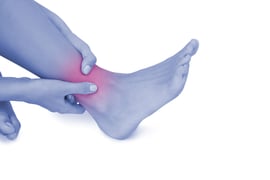 Complex Regional Pain Syndrome – formerly known as Reflex Sympathetic Dystrophy – is a chronic, debilitating disease of the sympathetic nervous system that typically affects more women than men. Those with CRPS suffer from chronic, intense pain throughout the body. Often, the condition results in long term disability.
Complex Regional Pain Syndrome – formerly known as Reflex Sympathetic Dystrophy – is a chronic, debilitating disease of the sympathetic nervous system that typically affects more women than men. Those with CRPS suffer from chronic, intense pain throughout the body. Often, the condition results in long term disability.
Knowing what evidence your insurance company will consider when reviewing your case will help increase your chances of benefit approval. Here’s what you need to know before filing your Complex Regional Pain Syndrome long term disability claim.
Is Complex Regional Pain Syndrome (CRPS) A Disability?
The chronic pain caused by CRPS can drastically reduce your quality of life. The symptoms can interfere with your sleep, your job, your relationships, and even your mental health. Unquestionably, CRPS is a disabling condition.
However, it can be an uphill battle to prove CRPS as disabling to your insurance company. First, many of the symptoms – mainly chronic pain - are considered subjective, making it difficult to prove the severity with the objective medical evidence your insurance company values most. Also, because CRPS is a rare disease, your insurance company may not be familiar with its symptoms.
To counter these challenges, it’s advised that you provide a detailed list and description of all your symptoms so your insurance company can better understand why and how they prevent you from working. This isn’t limited to physical symptoms – cognitive and secondary emotional symptoms may also apply to you as well. It’s important to have a full understanding of your symptoms and how they prevent you from working to help substantiate your CRPS disability claim.
Disabling Physical Symptoms of CRPS
 Complex Regional Pain Syndrome can cause an array of physical symptoms that may result in long term disability. These symptoms can be extremely limiting and distressing, preventing you from carrying out normal, everyday activities.
Complex Regional Pain Syndrome can cause an array of physical symptoms that may result in long term disability. These symptoms can be extremely limiting and distressing, preventing you from carrying out normal, everyday activities.
The physical signs and symptoms of Complex Regional Pain Syndrome include:
-
-
- Continuous, intense burning or throbbing pain, usually in your appendages (arms, legs, hands, and/or feet)
- Sensitivity to touch or cold
- Joint stiffness, swelling, and damage
- Muscle spasms, tremors, weakness, and atrophy
- Decreased ability to move the affected body part(s)
- Acute changes in skin temperature — alternating between sweaty and cold
- Changes in skin color, ranging from white and mottled to red or blue
- Changes in skin texture, which may become tender, thin, or shiny in the affected area
- Changes in hair and nail growth
- Fatigue
- Excessive sweating
-
The initial emerging symptoms of CRPS differ on a case-by-case basis, but typically the first to manifest are pain, burning, swelling, redness, skin temperature changes, and touch hypersensitivity. CRPS can cause excruciating pain (often described as similar to an electronic shock combined with a burning sensation). This pain, in rare cases, may even lead to muscle atrophy.
CRPS symptom frequency varies. For some, the symptoms go away on their own or with the aid of treatment. But for others, the symptoms may persist for months or years despite all available courses of treatment.
CRPS is sometimes a progressive condition, with symptoms changing over time. For example, the affected body part can become cold and pale. You may undergo skin and nail changes as well as muscle spasms and tightening. Or, the pain and other symptoms may spread from their original limb location to another body part, such as the opposite limb. Unfortunately, once these changes occur the condition is often irreversible.
In the advanced stages of Complex Regional Pain Syndrome, even a mere touch on the affected body part or exposure to sudden changes in temperature can trigger unbearable pain. This pain can also be accompanied by skin inflammation and/or changes in skin color or texture.
Disabling Cognitive and Secondary Emotional Symptoms of CRPS
 When preparing a CRPS long term disability claim, take time to consider your symptoms beyond the physical. Dealing with the intense, chronic pain and other physical symptoms of CRPS can lead to cognitive impairment and secondary emotional issues. These symptoms can also be disabling.
When preparing a CRPS long term disability claim, take time to consider your symptoms beyond the physical. Dealing with the intense, chronic pain and other physical symptoms of CRPS can lead to cognitive impairment and secondary emotional issues. These symptoms can also be disabling.
For example, the fatigue caused by your CRPS can cause cognitive issues such as problems with focus, concentration, and attention.
It is not common for the undue stress of dealing with chronic pain to lead to conditions such as clinical depression. If your CRPS causes you to suffer from depression, an anxiety disorder, or other mental illness, it is important for your medical records to reflect as much. Otherwise, your insurance company may mistake your subjective symptoms – chronic fatigue, chronic pain, etc. – as symptoms of an emotional condition, and approve you for benefits under a mental illness.
In that case, your benefits would likely be restricted to at most two years, even if you remained disabled beyond that time. Your claim must make it clear that your emotional symptoms (i.e. depression, anxiety, etc.) are secondary to your physical disability.
How Do I Prove My Complex Regional Pain Syndrome (CRPS) As A Disability?
To maximize your chances of long term disability approval, it’s vital to know what documentation your insurance company will value most when reviewing your CRPS disability claim. Even though CRPS can be challenging to prove as disabling, there are ways to substantiate your claim with evidence.
Proof of CRPS Diagnosis
 Your insurance company will require objective proof of diagnosis for any long term disability. Complex Regional Pain Syndrome is no exception. Unfortunately, this requirement can be challenging because no single test can diagnose CRPS. That creates difficulty when verifying its symptoms objectively.
Your insurance company will require objective proof of diagnosis for any long term disability. Complex Regional Pain Syndrome is no exception. Unfortunately, this requirement can be challenging because no single test can diagnose CRPS. That creates difficulty when verifying its symptoms objectively.
The first step in obtaining a diagnosis of Complex Regional Pain Syndrome is to visit your doctor. Your doctor will likely take a detailed medical history and conduct a thorough physical examination.
Because other conditions can cause similar symptoms, your doctor may recommend some testing to rule out another cause of your symptoms such as Lyme disease, arthritis, neuropathy, or muscle disease. They may also inquire about any prior injuries, since Complex Regional Pain Syndrome often appears following damage to the tissue or nerve of the affected area(s).
If your doctor suspects Complex Regional Pain Syndrome, they may suggest some procedures/testing to help confirm the diagnosis. For example:
-
-
- Bone Scan to look for a unique pattern of activity in the painful limb consistent with CRPS
- MRI to look for tissue changes consistent with CRPS
- Sympathetic Nervous System Tests such as a thermograph to measure the skin for temperature and blood flow changes in the affected limb to compare to the unaffected limb.
- X-ray to look for loss of minerals in your bones
-
The results of these tests will help your doctor determine if their CRPS diagnosis is correct. Findings that support your diagnosis should be included in your disability insurance claim as objective medical evidence.
Proof of Appropriate Treatment for CRPS
Nearly all disability insurance policies require that you receive appropriate treatment in order to get approved for long term disability benefits. Your insurance company will want proof you are making every good faith effort to improve your condition.
Unfortunately, there is no known cure for CRPS, but there are a variety of treatment methods that can help to reduce an individual’s symptoms. Common treatment/therapy options for Complex Regional Pain Syndrome include:
-
-
- Medications. Although there is no medication specifically developed for CRPS, your doctor may suggest that you take medications to help with the pain and swelling. These medications may include (without limitation):
- Nonsteroidal anti-inflammatory drugs (“NSAIDs”) such as aspirin, ibuprofen (Advil, Motrin), and naproxen (Aleve). These are all available over the counter.
- Corticosteroids such as prednisone.
- Opioid pain medications for severe pain such as oxycodone, morphine, or hydrocodone.
- Anti-seizure and anti-depression medications such as gabapentin, amitriptyline, nortriptyline, or duloxetine. These medications are thought to be effective in treating neuropathic pain.
- Sympathetic nerve block. This is an injection of an anesthetic (pain reliever) into certain nerves that blocks the pain signals. If the injection relieves the pain, it may be repeated. However, this is not a cure for CRPS.
- Neural stimulation. This involves stimulating nerves with electrical or magnetic currents. Some types, such as spinal cord stimulation, require minor surgery.
- Physical therapy. Keeping the body part moving increases circulation and promotes healing.
- Sympathectomy of the injured nerve. This is a surgical procedure where a surgeon cuts or clamps the nerve chain thought to be producing the pain.
- Psychotherapy. People with chronic pain may develop mental health disorders. These include depression or anxiety, which can heighten pain. Psychotherapy helps you cope with the pain. It also helps you cope with any conditions that develop.
-
Some additional/experimental treatment methods are gaining steam, including, without limitation:
-
-
- Intravenous immunoglobulin (IVIG). Some individuals who have received these infusions have reported a decrease in their pain.
- Ketamine. Some doctors are using low doses of Ketamine (a strong anesthetic) – administered intravenously for several days – as a way of treating severe pain when other methods have been unsuccessful.
-
With early treatment, an individual may be able to keep Complex Regional Pain Syndrome from advancing. Early treatment also occasionally improves or eliminates CRPS symptoms. However, many people with long-lasting, more severe symptoms do not respond to treatment. In those cases, a pain management program for chronic pain may be beneficial.
Keep in mind that some courses of treatment for CRPS – especially medications – may cause additional disabling symptoms, such as cognitive impairment or drowsiness. If you suffer from physical or cognitive symptoms as a result of your CRPS treatment, make sure they are well-documented for your long term disability claim.
Always follow your doctor’s advice and treatment recommendations. Your insurance company can easily use non-compliance and lack of appropriate care as a reason to deny your claim.
A Supportive Doctor Goes A Long Way
 When determining whether your Complex Regional Pain Syndrome is disabling, objective medical evidence may hold the most weight with your insurance company. That said, they will also want the opinions of your treating doctor(s). As with any disability case, your doctor’s support is key.
When determining whether your Complex Regional Pain Syndrome is disabling, objective medical evidence may hold the most weight with your insurance company. That said, they will also want the opinions of your treating doctor(s). As with any disability case, your doctor’s support is key.
Request that your doctor prepare a narrative letter discussing your CRPS and why you can no longer work as a result of your condition. Your doctor’s report should focus on the frequency and severity of your symptoms, their direct observations of you during office visits, any objective physical examination findings, and your specific restrictions and limitations that prevent you from working.
Explain Your CRPS Disability in Your Own Words
There is no doubt that Complex Regional Pain Syndrome can be extremely distressing and disabling. However, given the rarity of the disease, your insurance company may not understand the nature and severity of your symptoms or the impact they have on your job. Medical records documenting your symptoms can help, but sometimes they do not provide the full picture of how your condition affects your ability to work.
To increase your chances of approval, you can explain to your insurance company how and why each of your symptoms prevents you from performing your job duties in a personal statement.
For example, if your CRPS pain and inflammation presents in your arms, wrists, or hands, you may have difficulty writing or using a computer. In particular, typing on a computer and using the mouse may become next to impossible for more than short periods of time. Consequently you may find you are performing your work tasks at a much slower pace. This may result in your failure to file a report within a deadline, or your failure to respond to a client’s email promptly.
If you experience CRPS pain and swelling in your legs and feet, you may have difficulty traveling to an out-of-office meeting with your employer’s biggest client. Worse yet, hypersensitivity to touch may prevent you from putting on your socks and shoes or from wearing appropriate work attire. This can prevent you from leaving your house, let alone attending that off-site meeting.
Also, most executive-level jobs require a high level of cognitive functioning. Your severe pain, swelling, and muscle spasms may interfere with your ability to focus and concentrate at an important meeting. Or you may not remember the details of a recent conversation with your co-worker or boss. Your pain may keep you up all night, resulting in fatigue the next day. This, too, can make it difficult to focus, concentrate, and pay attention. It can also result in irritability causing you to have a “short fuse” with co-workers and/or clients.
Therefore, it is often beneficial to explain exactly how your individual symptoms prevent you from performing your job duties by preparing a detailed, written narrative for the insurance company. Because many symptoms of Complex Regional Pain Syndrome are subjective in nature, your narrative can also address the severity of your symptoms, as well as any factors that trigger or exacerbate your symptoms.
A Disability Attorney Can Help
Complex Regional Pain Syndrome is a debilitating condition – and an often misunderstood one. Because of this, getting approved for long term disability can be difficult. Your insurance company may not have familiarity with CRPS, write off your symptoms as the result of a mental illness, or feel there is not enough strong evidence to show why you cannot work.
An experienced long term disability insurance attorney knows what your insurance company is looking for. They can prepare a disability claim substantiated with strong medical and vocational evidence, diagnostic testing results, and proof of appropriate treatment that fully explains your disability to your insurance company.
New York disability attorneys with a proven track record of handling ERISA long term disability insurance claims can help. If you suffer from CRPS and are considering filing for long term disability, or recently had your disability claim denied, call Riemer Hess LLC, Attorneys at Law, to arrange a consultation: 212-297-0700.














